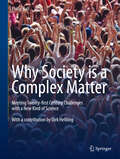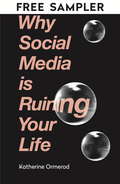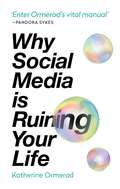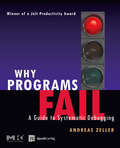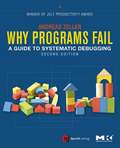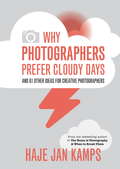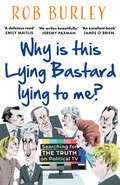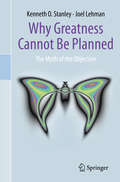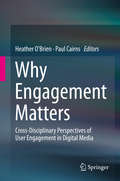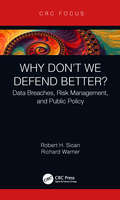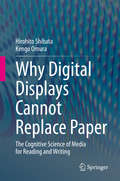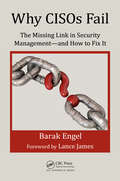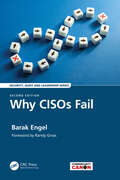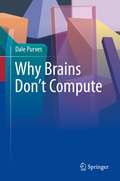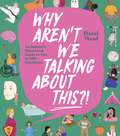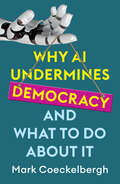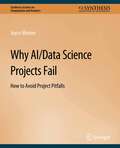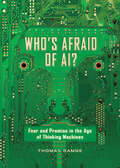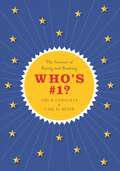- Table View
- List View
Why Society is a Complex Matter: Meeting Twenty-first Century Challenges with a New Kind of Science
by Philip BallSociety is complicated. But this book argues that this does not place it beyond the reach of a science that can help to explain and perhaps even to predict social behaviour. As a system made up of many interacting agents – people, groups, institutions and governments, as well as physical and technological structures such as roads and computer networks – society can be regarded as a complex system. In recent years, scientists have made great progress in understanding how such complex systems operate, ranging from animal populations to earthquakes and weather. These systems show behaviours that cannot be predicted or intuited by focusing on the individual components, but which emerge spontaneously as a consequence of their interactions: they are said to be ‘self-organized’. Attempts to direct or manage such emergent properties generally reveal that ‘top-down’ approaches, which try to dictate a particular outcome, are ineffectual, and that what is needed instead is a ‘bottom-up’ approach that aims to guide self-organization towards desirable states.This book shows how some of these ideas from the science of complexity can be applied to the study and management of social phenomena, including traffic flow, economic markets, opinion formation and the growth and structure of cities. Building on these successes, the book argues that the complex-systems view of the social sciences has now matured sufficiently for it to be possible, desirable and perhaps essential to attempt a grander objective: to integrate these efforts into a unified scheme for studying, understanding and ultimately predicting what happens in the world we have made. Such a scheme would require the mobilization and collaboration of many different research communities, and would allow society and its interactions with the physical environment to be explored through realistic models and large-scale data collection and analysis. It should enable us to find new and effective solutions to major global problems such as conflict, disease, financial instability, environmental despoliation and poverty, while avoiding unintended policy consequences. It could give us the foresight to anticipate and ameliorate crises, and to begin tackling some of the most intractable problems of the twenty-first century.
Why Social Media is Ruining Your Life
by Katherine Ormerod**FREE SAMPLER**'This book is a call to arms from the eye of the storm'- Emma Gannon, author of The Multi Hyphen MethodDo you ever obsess about your body? Do you lie awake at night, fretting about the state of your career? Does everyone else's life seem better than yours? Does it feel as if you'll never be good enough? Get a first glimpse of Why Social Media is Ruining Your Life with this exclusive free sampler, and learn how to tackle head on the pressure cooker of comparison and unreachable levels of perfection that social media has created in our modern world.In this book, Katherine Ormerod meets the experts involved in curating, building and combating the most addictive digital force humankind has ever created. From global influencers - who collectively have over 10 million followers - to clinical psychologists, plastic surgeons and professors, Katherine uncovers how our relationship with social media has rewired our behavioural patterns, destroyed our confidence and shattered our attention spans.Why Social Media is Ruining Your Life is a call to arms that will provide you with the knowledge, tactics and weaponry you need to find a more healthy way to consume social media and reclaim your happiness.
Why Social Media is Ruining Your Life
by Katherine OrmerodDo you ever obsess about your body? Do you lie awake at night, fretting about the state of your career?Does everyone else's life seem better than yours? Does it feel as if you'll never be good enough? Why Social Media is Ruining Your Life tackles head on the pressure cooker of comparison and unreachable levels of perfection that social media has created in our modern world.In this book, Katherine Ormerod meets the experts involved in curating, building and combating the most addictive digital force humankind has ever created. From global influencers - who collectively have over 10 million followers - to clinical psychologists, plastic surgeons and professors, Katherine uncovers how our relationship with social media has rewired our behavioural patterns, destroyed our confidence and shattered our attention spans.Why Social Media is Ruining Your Life is a rallying cry that will provide you with the knowledge, tactics and weaponry you need to find a more healthy way to consume social media and reclaim your happiness.Reviews for Why Social Media is Ruining Your Life:'This book is a call to arms from the eye of the storm'- Emma Gannon, author of The Multi-Hyphen Method'Enter Ormerod's vital manual, which will help you navigate social media and turn it not into a weapon, but a useful tool' - Pandora Sykes
Why Programs Fail: A Guide to Systematic Debugging
by Andreas ZellerWhy Programs Fail is about bugs in computer programs, how to find them, how to reproduce them, and how to fix them in such a way that they do not occur anymore. This is the first comprehensive book on systematic debugging and covers a wide range of tools and techniques ranging from hands-on observation to fully automated diagnoses, and includes instructions for building automated debuggers. This discussion is built upon a solid theory of how failures occur, rather than relying on seat-of-the-pants techniques, which are of little help with large software systems or to those learning to program. The author, Andreas Zeller, is well known in the programming community for creating the GNU Data Display Debugger (DDD), a tool that visualizes the data structures of a program while it is running.Winner of a 2006 Jolt Productivity Award for Technical BooksShows how to reproduce software failures faithfully, how to isolate what is important about the failure, and to discover what caused itDescribes how to fix the program in the best possible way, and shows how to create your own automated debugging toolsIncludes exercises and extensive references for further study
Why Programs Fail: A Guide to Systematic Debugging
by Andreas ZellerWhy Programs Fail: A Guide to Systematic Debugging is proof that debugging has graduated from a black art to a systematic discipline. It demystifies one of the toughest aspects of software programming, showing clearly how to discover what caused software failures, and fix them with minimal muss and fuss. The fully updated second edition includes 100+ pages of new material, including new chapters on Verifying Code, Predicting Erors, and Preventing Errors. Cutting-edge tools such as FindBUGS and AGITAR are explained, techniques from integrated environments like Jazz.net are highlighted, and all-new demos with ESC/Java and Spec#, Eclipse and Mozilla are included. This complete and pragmatic overview of debugging is authored by Andreas Zeller, the talented researcher who developed the GNU Data Display Debugger(DDD), a tool that over 250,000 professionals use to visualize the data structures of programs while they are running. Unlike other books on debugging, Zeller's text is product agnostic, appropriate for all programming languages and skill levels. The book explains best practices ranging from systematically tracking error reports, to observing symptoms, reproducing errors, and correcting defects. It covers a wide range of tools and techniques from hands-on observation to fully automated diagnoses, and also explores the author's innovative techniques for isolating minimal input to reproduce an error and for tracking cause and effect through a program. It even includes instructions on how to create automated debugging tools. The text includes exercises and extensive references for further study, and a companion website with source code for all examples and additional debugging resources is available.The new edition of this award-winning productivity-booster is for any developer who has ever been frustrated by elusive bugsBrand new chapters demonstrate cutting-edge debugging techniques and tools, enabling readers to put the latest time-saving developments to work for themLearn by doing. New exercises and detailed examples focus on emerging tools, languages and environments, including AGITAR, FindBUGS, Python and Eclipse
Why Photographers Prefer Cloudy Days: and 61 Other Ideas for Creative Photography
by Haje Jan KampsThere's no one secret to taking beautiful photos. But good photographers do have a few tricks up theirsleeves... They know that clouds, far from ruining a photo, give a great soft natural light for portraits. They know that unusual angles draw the eye, and that their feet are just as effective as a zoom lens.This book packs 62 of the most important creative ideas into one place. Beautifully presented, easy-to-read and packed with example photos. None of these ideas need an expensive camera, fancy lens or a over-priced flash. The purpose of this book is to help you tell stories with your camera (or phone).Whatever you want to shoot, Why Photographers Prefer Cloudy Days is packed full of ideas to inspire you, and tips that will help you take better, more original photos.
Why Is This Lying Bastard Lying to Me?: Searching For The Truth On Political Tv
by Rob BurleyA deliciously irreverent and humorous insider’s account of 25 years working at the very top of British political television ‘What Rob Burley doesn't know about political interviewing isn't worth knowing’ – Andrew Neil
Why Information Grows: The Evolution of Order, from Atoms to Economies
by César HidalgoIn Why Information Grows, rising star César Hidalgo offers a radical interpretation of global economicsWhile economists often turn to measures like GDP or per-capita income, César Hidalgo turns to information theory to explain the success or failure of a country's economic performance. Through a radical rethinking of what the economy is, Hidalgo shows that natural constraints in our ability to accumulate knowledge, knowhow and information explain the evolution of social and economic complexity. This is a rare tour de force, linking economics, sociology, physics, biology and information theory, to explain the evolution of social and economic systems as a consequence of the physical embodiment of information in a world where knowledge is quite literally power.César Hidalgo leads the Macro Connections group at the MIT Media Lab. A trained statistical physicist and an expert on Networks and Complex Systems, he also has extensive experience in the field of economic development and has pioneered research on how big data impacts economic decision-making.
Why Greatness Cannot Be Planned: The Myth of the Objective
by Kenneth O. Stanley Joel LehmanWhy does modern life revolve around objectives? From how science is funded, to improving how children are educated -- and nearly everything in-between -- our society has become obsessed with a seductive illusion: that greatness results from doggedly measuring improvement in the relentless pursuit of an ambitious goal. In Why Greatness Cannot Be Planned, Stanley and Lehman begin with a surprising scientific discovery in artificial intelligence that leads ultimately to the conclusion that the objective obsession has gone too far. They make the case that great achievement can't be bottled up into mechanical metrics; that innovation is not driven by narrowly focused heroic effort; and that we would be wiser (and the outcomes better) if instead we whole-heartedly embraced serendipitous discovery and playful creativity.Controversial at its heart, yet refreshingly provocative, this book challenges readers to consider life without a destination and discovery without a compass.
Why Fonts Matter
by Sarah HyndmanWe all constantly interact with type in almost every aspect of our lives. But how do fonts affect what we read and influence the choices we make?This book opens up the science and the art behind how fonts influence you. It explains why certain fonts or styles evoke particular experiences and associations. Fonts have different personalities that can create trust, mistrust, give you confidence, make things seem easier to do or make a product taste better. They’re hidden in plain sight, they trigger memories, associations and multisensory experiences in your imagination.* Fonts can alter the meanings of words right before your very eyes.* See what personalities fonts have, and what they reveal about YOUR personality.* Explore how you respond to fonts emotionally and can make fonts work for your message.* Be amazed that a font has the power to alter the taste of your food.This book is for anyone who is interested in giving words impact, who loves words and how they influence us.
Why Engagement Matters: Cross-Disciplinary Perspectives of User Engagement in Digital Media
by Heather O'Brien Paul CairnsUser Engagement (UE) is a complex concept to investigate. The purpose of this book is not to constrain UE to one perspective, but to offer a well-rounded appreciation for UE across various domains and disciplines. The text begins with two foundational chapters that describe theoretical and methodological approaches to user engagement; the remaining contributions examine UE from different disciplinary perspectives and across a range of computer-mediated environments, including social and communications media, online search, eLearning, games, and eHealth. The book concludes by bringing together the cross-disciplinary perspectives presented in each chapter and proposing an agenda for future research in this area. The book will appeal to established and emerging academic and industry researchers looking to pursue research and its challenges. This includes scholars at all levels with an interest in user engagement with digital media, from students to experienced researchers, and professionals in the fields of computer science, web technology, information science, museum studies, learning and health sciences, human-computer interaction, information architecture and design, and creative arts.
Why Don't We Defend Better?: Data Breaches, Risk Management, and Public Policy
by Robert H. Sloan Richard WarnerThe wave of data breaches raises two pressing questions: Why don’t we defend our networks better? And, what practical incentives can we create to improve our defenses? Why Don't We Defend Better?: Data Breaches, Risk Management, and Public Policy answers those questions. It distinguishes three technical sources of data breaches corresponding to three types of vulnerabilities: software, human, and network. It discusses two risk management goals: business and consumer. The authors propose mandatory anonymous reporting of information as an essential step toward better defense, as well as a general reporting requirement. They also provide a systematic overview of data breach defense, combining technological and public policy considerations. Features Explains why data breach defense is currently often ineffective Shows how to respond to the increasing frequency of data breaches Combines the issues of technology, business and risk management, and legal liability Discusses the different issues faced by large versus small and medium-sized businesses (SMBs) Provides a practical framework in which public policy issues about data breaches can be effectively addressed
Why Don't We Defend Better?: Data Breaches, Risk Management, and Public Policy
by Robert H. Sloan Richard WarnerThe wave of data breaches raises two pressing questions: Why don’t we defend our networks better? And, what practical incentives can we create to improve our defenses? Why Don't We Defend Better?: Data Breaches, Risk Management, and Public Policy answers those questions. It distinguishes three technical sources of data breaches corresponding to three types of vulnerabilities: software, human, and network. It discusses two risk management goals: business and consumer. The authors propose mandatory anonymous reporting of information as an essential step toward better defense, as well as a general reporting requirement. They also provide a systematic overview of data breach defense, combining technological and public policy considerations. Features Explains why data breach defense is currently often ineffective Shows how to respond to the increasing frequency of data breaches Combines the issues of technology, business and risk management, and legal liability Discusses the different issues faced by large versus small and medium-sized businesses (SMBs) Provides a practical framework in which public policy issues about data breaches can be effectively addressed
Why Digital Displays Cannot Replace Paper: The Cognitive Science of Media for Reading and Writing
by Hirohito Shibata Kengo OmuraFrom readability to operability, this book presents a number of experiments to analyze the characteristics of paper and digital displays in reading and writing. Why is it easy to read on paper? Why is it easy to concentrate on reading on paper? Why is it easy to think while writing or drawing on paper? This book answers these questions based on cognitive experiments on media. Paper is easy to read because it is easy to handle. If we emphasize the strengths of paper, paper is an operation media rather than a presentation media. These experiments also indicate how to develop digital media for reading and writing.This book will interest those who want to gain a scientific understanding of reading and writing on paper, those who want to work more effectively by selectively using paper and digital tools (e.g. knowledge workers and educators), and those who develop digital devices or services for reading and writing.
Why Cryptography Should Not Rely on Physical Attack Complexity (T-Labs Series in Telecommunication Services)
by Juliane KrämerThis book presents two practical physical attacks. It shows how attackers can reveal the secret key of symmetric as well as asymmetric cryptographic algorithms based on these attacks, and presents countermeasures on the software and the hardware level that can help to prevent them in the future. Though their theory has been known for several years now, since neither attack has yet been successfully implemented in practice, they have generally not been considered a serious threat. In short, their physical attack complexity has been overestimated and the implied security threat has been underestimated. First, the book introduces the photonic side channel, which offers not only temporal resolution, but also the highest possible spatial resolution. Due to the high cost of its initial implementation, it has not been taken seriously. The work shows both simple and differential photonic side channel analyses. Then, it presents a fault attack against pairing-based cryptography. Due to the need for at least two independent precise faults in a single pairing computation, it has not been taken seriously either.Based on these two attacks, the book demonstrates that the assessment of physical attack complexity is error-prone, and as such cryptography should not rely on it. Cryptographic technologies have to be protected against all physical attacks, whether they have already been successfully implemented or not. The development of countermeasures does not require the successful execution of an attack but can already be carried out as soon as the principle of a side channel or a fault attack is sufficiently understood.
Why CISOs Fail: The Missing Link in Security Management--and How to Fix It (Internal Audit and IT Audit)
by Barak EngelThis book serves as an introduction into the world of security and provides insight into why and how current security management practices fail, resulting in overall dissatisfaction by practitioners and lack of success in the corporate environment. The author examines the reasons and suggests how to fix them. The resulting improvement is highly beneficial to any corporation that chooses to pursue this approach or strategy and from a bottom-line and business operations perspective, not just in technical operations. This book transforms the understanding of the role of the CISO, the selection process for a CISO, and the financial impact that security plays in any organization.
Why CISOs Fail: The Missing Link in Security Management--and How to Fix It (Internal Audit and IT Audit)
by Barak EngelThis book serves as an introduction into the world of security and provides insight into why and how current security management practices fail, resulting in overall dissatisfaction by practitioners and lack of success in the corporate environment. The author examines the reasons and suggests how to fix them. The resulting improvement is highly beneficial to any corporation that chooses to pursue this approach or strategy and from a bottom-line and business operations perspective, not just in technical operations. This book transforms the understanding of the role of the CISO, the selection process for a CISO, and the financial impact that security plays in any organization.
Why CISOs Fail (Security, Audit and Leadership Series)
by Barak EngelReleased in 2017, the first edition of Why CISOs Fail reimagined the role of the Chief Information Security Officer in a new and powerful way. Written to be easily consumable by both security pros as well as everyone who must deal with them, the book explores the different realms in which security leaders fail to deliver meaningful impact to their organizations, and why this happens. Its central thesis—that security is primarily a human behavioral discipline rather than a technology one—has been gaining increased attention as a core tenet of the field, and the book was ultimately inducted into the cybersecurity canon as a leading book on security management.In this freshly updated edition, Barak Engel adds new sections that correspond with the chapters of the original book: security as a discipline; as a business enabler; in sales; in legal; in compliance; in technology; and as an executive function. He explores new ideas in each operational area, providing essential insights into emerging aspects of the discipline. He then proposes two critical concepts for security management—the concept of "digital shrinkage" and the transition from CISO to CI/SO—that together offer a new paradigm for any organization that wants to become truly successful in its security journey.Why CISOs (Still) Fail is delivered in Barak's conversational, humoristic style, that has attracted a global audience to this and his other book, The Security Hippie. As he notes, the book's goal is to entertain as much as to inform, and he dearly hopes that you have fun reading it.
Why CISOs Fail: The Missing Link In Security Management--and How To Fix It (Security, Audit and Leadership Series)
by Barak EngelReleased in 2017, the first edition of Why CISOs Fail reimagined the role of the Chief Information Security Officer in a new and powerful way. Written to be easily consumable by both security pros as well as everyone who must deal with them, the book explores the different realms in which security leaders fail to deliver meaningful impact to their organizations, and why this happens. Its central thesis—that security is primarily a human behavioral discipline rather than a technology one—has been gaining increased attention as a core tenet of the field, and the book was ultimately inducted into the cybersecurity canon as a leading book on security management.In this freshly updated edition, Barak Engel adds new sections that correspond with the chapters of the original book: security as a discipline; as a business enabler; in sales; in legal; in compliance; in technology; and as an executive function. He explores new ideas in each operational area, providing essential insights into emerging aspects of the discipline. He then proposes two critical concepts for security management—the concept of "digital shrinkage" and the transition from CISO to CI/SO—that together offer a new paradigm for any organization that wants to become truly successful in its security journey.Why CISOs (Still) Fail is delivered in Barak's conversational, humoristic style, that has attracted a global audience to this and his other book, The Security Hippie. As he notes, the book's goal is to entertain as much as to inform, and he dearly hopes that you have fun reading it.
Why Brains Don't Compute
by Dale PurvesThis book examines what seems to be the basic challenge in neuroscience today: understanding how experience generated by the human brain is related to the physical world we live in. The 25 short chapters present the argument and evidence that brains address this problem on a wholly trial and error basis. The goal is to encourage neuroscientists, computer scientists, philosophers, and other interested readers to consider this concept of neural function and its implications, not least of which is the conclusion that brains don’t “compute.”
WHY AREN'T WE TALKING ABOUT THIS?!: An Inclusive Illustrated Guide to Life in 100+ Questions
by Hazel Mead'Informative and bold' Dr Karen Gurney | 'Compassionate, artistic, tasteful' Joshua FletcherWhat is the most personal thing you've asked the Internet? Illustrator Hazel Mead turns to Google to uncover what we secretly ask search bars about our relationships, bodies and identities. With hundreds of demystifying and empowering illustrations, she offers a fun, shame-free and inclusive guide to life's big questions. This is the emotional curriculum you'll wish was taught in every classroom.What if there was a book that explored the big lessons of life? Sure, formal education will equip you with requisite knowledge on photosynthesis. But when it comes to spotting the green flags in a prospective partner, navigating yours or a loved one's grief, knowing how to prepare for a cervical screening, or to practicing self-defense, it can feel like total guesswork.Using the latest research, interviews with experts, and her signature visuals, Hazel interrogates the taboos that shame us into silence. Since the answers to life's big questions are rarely black and white, she answers them in colour, with accessible design and compassionate reflections. Why Aren't We Talking About This?! is an exploration of the things we're too afraid to ask but desperately need to know and talk about for greater acceptance of others and ourselves. It's a bold invitation to forget normal and embrace what makes you unique.
Why AI Undermines Democracy and What To Do About It
by Mark CoeckelberghAcross the world, AI is used as a tool for political manipulation and totalitarian repression. Stories about AI are often stories of polarization, discrimination, surveillance, and oppression. Is democracy in danger? And can we do anything about it? In this compelling and balanced book, Mark Coeckelbergh reveals the key risks posed by AI for democracy. He argues that AI, as currently used and developed, undermines fundamental principles on which liberal democracies are founded, such as freedom and equality. How can we make democracy more resilient in the face of AI? And, more positively, what can AI do for democracy? Coeckelbergh advocates not only for more democratic technologies, but also for new political institutions and a renewal of education to ensure that AI promotes, rather than hinders, the common good for the twenty-first century. Why AI Undermines Democracy and What to Do About It is illuminating reading for anyone who is concerned about the fate of democracy.
Why AI/Data Science Projects Fail: How to Avoid Project Pitfalls (Synthesis Lectures on Computation and Analytics)
by Joyce WeinerRecent data shows that 87% of Artificial Intelligence/Big Data projects don’t make it into production (VB Staff, 2019), meaning that most projects are never deployed. This book addresses five common pitfalls that prevent projects from reaching deployment and provides tools and methods to avoid those pitfalls. Along the way, stories from actual experience in building and deploying data science projects are shared to illustrate the methods and tools. While the book is primarily for data science practitioners, information for managers of data science practitioners is included in the Tips for Managers sections.
Who's Afraid of AI?: Fear and Promise in the Age of Thinking Machines
by Thomas RamgeA penetrating guide to artificial intelligence: what it is, what it does, and how it will change our lives At a breathtaking pace, artificial intelligence is getting better and faster at making complex decisions. AI can already identify malignant tumors on CT scans, give legal advice, out-bluff the best poker players in the world, and, with ever-increasing skill, drive our cars. In Who&’s Afraid of AI?, award-winning author Thomas Ramge expertly explains how machines are learning to learn, and he questions what today&’s explosion of AI capability could mean for tomorrow: Is it ethical to allow robots—endlessly patient—to replace human caregivers in providing comfort and companionship to the elderly?Since AI feeds on big data, can we prevent its misuse by corporations or the government?Will AI ever be capable of runaway self-improvement? And if &“the singularity&” does arrive, with AI&’s intelligence exponentially outpacing our own, what will become of us when, in many ways, we&’re obsolete?
Who's #1?: The Science of Rating and Ranking
by Amy N. Langville Carl D. MeyerA website's ranking on Google can spell the difference between success and failure for a new business. NCAA football ratings determine which schools get to play for the big money in postseason bowl games. Product ratings influence everything from the clothes we wear to the movies we select on Netflix. Ratings and rankings are everywhere, but how exactly do they work? Who's #1? offers an engaging and accessible account of how scientific rating and ranking methods are created and applied to a variety of uses. Amy Langville and Carl Meyer provide the first comprehensive overview of the mathematical algorithms and methods used to rate and rank sports teams, political candidates, products, Web pages, and more. In a series of interesting asides, Langville and Meyer provide fascinating insights into the ingenious contributions of many of the field's pioneers. They survey and compare the different methods employed today, showing why their strengths and weaknesses depend on the underlying goal, and explaining why and when a given method should be considered. Langville and Meyer also describe what can and can't be expected from the most widely used systems. The science of rating and ranking touches virtually every facet of our lives, and now you don't need to be an expert to understand how it really works. Who's #1? is the definitive introduction to the subject. It features easy-to-understand examples and interesting trivia and historical facts, and much of the required mathematics is included.
